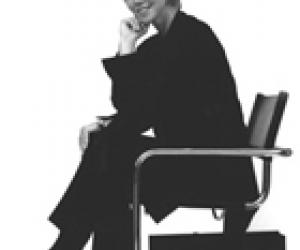First Published in
Mary Lewis is a recipient of the British Design & Art Direction President's Award in 2001 for Outstanding Contribution to Design and her numerous awards include D&AD Gold and three Silver Awards, DBA Grand Prix and International Brand Packaging Awards. She is a brand identity designer whose prestigious clients include Champagne Bollinger, Le Bon Marché, Jasper Conran, HRH The Prince of Wales, Stuart Crystal and The Royal Mail. Currently she is developing the brand portfolio for Harrods, conducting global projects for Johnson & Johnson and is a consultant to Marks & Spencer. She is contributing author to Understanding Brands.
Design Indaba asked prominent South African designer, Joanne Thomas of The Jupiter Drawing Room to conduct an interview. Given Joanne's own portfolio, particularly in packaging design, we thought she would have the inside track.
I was interested to find out that you started your career in advertising. It would seemthat in the UK and Europe the areas of advertising and design are very defined and separate, whereas in South Africa increasingly agencies are boasting a "through-the-line approach" covering everything from design through to "above-the-line" advertising. What did you learn from your time in advertising? And can the two worlds learn from each other?
I loved working in advertising and enjoy sharp brains, quick wit and the ability to sum up in a second. These skills are equally relevant and potent in the hands of the designer. However the conflict between the two worlds has always baffled me. Advertising is transient, you can walk past a poster and turn off the TV. But design is enduring. You take it home with you. Apart from that, both disciplines are there to amplify the brand. A common goal to be achieved in partnership. This is how we successfully work with advertising agencies.
Was there any other career path you could have taken?
Post art school I abandoned graphic design and worked as a fine art printmaker, teaching in art schools to support this and using the printmaking facilities during the holidays. I was teaching graphic design and after three years I began to worry that I'd never actually done it. I set out to tackle some projects and never went back.
You'll be speaking at the Design Indaba in South Africa in February next year, do you travel a lot? And how do these travels inspire you?
Travel is one of the best things about what I do. Our clients are international and my bag stays ready and packed. Our client base is diverse both in type and provenance. Which means it can be New York one week and a one horse town in the Caucasus the next... Identifying local nuances is essential to what I do. It stimulates professional and personal curiosity.
Is there any one particular country that you think sits at the forefront of design? And who's next?
Different countries have difference strengths. America produces stunning annual reports, Japan understands the packaging ritual better than anyone else, here in the UK we have a design literate audience to keep us on our toes and South Africa is producing some beautifully crafted work… As boundaries recede it's hard to pinpoint, but Russia must be poised to reclaim and enjoy a visual extravaganza.
What's your fantasy job?
It would be back in the printroom, with no pressures but my own, surrounded by the ritual of the medium, a whole long day ahead of me, and rows of empty racks waiting for my prints…
We often struggle with trying to understand how sophisticated our emerging mass market is in South Africa -will they understand and appreciate good design? Do you think that designers can "lead" a market to a better understanding of design?
Yes, yes, yes. But not by promoting design. Solve problems, create something of beauty, readily understood and valued, and you have fans. Once the ball is rolling design is 'must have' - and not exclusive.
If I say "African design" what picture leaps to mind?
The profile of a majestic elephant leading more elephants of smaller sizes through the haze of early morning... Wow. Designer: God.
What's been the proudest moment in your career?
Winning the British Design and Art Direction Gold Award for Outstanding Design.
The seemingly unattainable Gold at D&AD. What piece of work was this for?
The award was given for the design of the launch wines in a range of over three hundred labels for UK retailer Asda. In 1988 when the project was commissioned supermarket packaging was either a cheap apology of a brand lookalike. Marketers patronised the mass market, and retailers peddled price points over quality and were yet to wake up to the power of their own brand.
In the retail arena, Asda was personified by its irreverence and "northern confidence". The design concept took its inspiration from high-end branded wines - Baron Philippe de Rothschild and its portfolio of artists. Delivering "art" at £2 a bottle was a challenge in itself. A host of enthusiastic creatives including sculptors, ceramists and photographers were briefed to create images for each label design. Some were famous, others just graduating. They all signed the label, and a brave and visionary client was persuaded that there could be no compromise. What was proposed as a design, was to be used.
Each label was entirely individual with no reference to brands or category. The wine critic Malcolm Gluck described it as a "glittering array nictating like gems". Industry benchmarker Beryl McAlhone described it as "Mould breaking work". Several artists were set on course for fame and fortune, Asda's sales rose and marketers were left scratching their heads as to its success. The message is "don't underestimate the consumer and don't do things in half measures".
Your company's successes continue to stream in - not least of all the D&AD Presidents Award that you personally received - do you find it difficult to keep up the goodwork?
It's always hard to keep up good work, but if it wasn't hard it wouldn't be good.
How important are awards to you personally and secondly to your business?
My rational answer is that the two are intrinsically linked. Awards are not an indulgence they are a commercial asset. They attract the best designers to our team who in turn do the best work for our clients.
My emotional response is that I love to win them…
Your design or that of Lewis Moberly has always been the kind of design that makes me say " I wish I'd done that.." Is there any piece of design that you wish you had done?
There are lots but one in particular... Chanel No 5
Humour often seems to play an integral part of your design. Are you just a funny bunch of people or is there a deeper philosophy behind your design?
I don't think humour looms large in our portfolio. But in our quest for simplicity,wit can thrive. All projects require different approaches. We say we design bin liners (Boots Bin Liners) and Bolly (Champagne Bollinger). We're probably also a funny bunch of people…
About this 'bunch of people' - how many people do you haveworking in your offices? And what qualities do you look for when hiring new people to work with you?
We have a team of thirty people, ten of whom are designers. In hiring I look for particular talents to balance what I think we may need at any one time. They should have a real passion for design, be hungry for projects and competitive in spirit. I enjoy working with strong individuals who bring something through their personality to the culture of the team and can argue their case. I also enjoy designers who have worked in different disciplines to ours, they have no preconcieved ideas and I experiment with creatives who have changed career e.g. banker to designer…
Fighting spirit? Could you elaborate on this?
Fighting spirit is the quality which takes a design without compromise, from conception to production. It has the power to survive marketing institutionalism and emerge unscathed. Apple would be a good example, though in this case the vision was driven from the top, but that tells its own story.
What projects are you currently involved in?
Ironically, Baron Philippe de Rothschild - fifteen years after the Asda project. Johnson and Johnson, on international projects for some of their leading brands. Harrods, the redesign of their own brand range. Pol Roger, the renowned champagne house and Marks and Spencer where I work as a consultant.
Do you continue to be challenged by new briefs?
Yes, but experience does reduce tolerance. Briefs I take on now have to be well worked. I lose patience with creative wastage and only begin design when the objectives are clear. I like a real problem to solve, then there's the challenge of doing it beautifully and appropriately.
Where does your inspiration come from?
Life.
Any career low points?
We were asked by The Observer newspaper to propose the packaging design for Cannabis, should it become legal. The work made the front cover of the supplement and included a design by our newest recruit featuring vibrating vertical stripes. I only discovered they belonged to Bridget Riley when I got a letter from her solicitor…
If you were to go through your pantry at home right now - which is the best piece of packaging you would find there?
My little bottle of Angostura Bitters. It's been there a long time, you only use a little and they don't change the design. It's a rebel. Label's too big, types too small and it's wall to wall text - and no colour except a touch of red and a strange yellow top. No brand manager ever got near it and I don't want to be asked to redesign it.
What do you consider to be the key components of great design?
Relevance, Distinction, Intelligence, Tension, Aesthetic pleasure, Fighting spirit.














